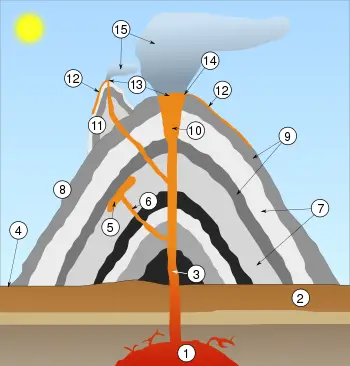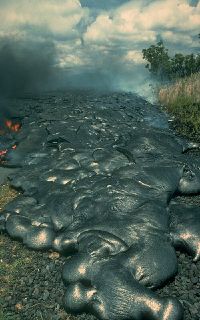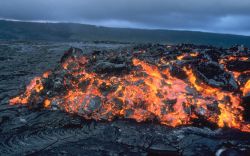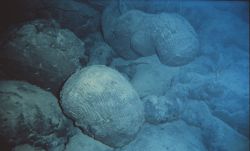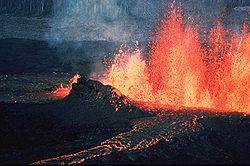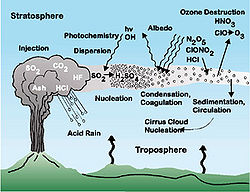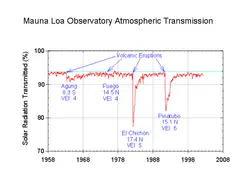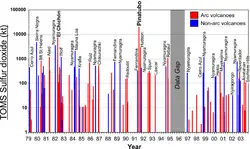Difference between revisions of "Volcano" - New World Encyclopedia
(added credit and category tags) |
|||
| (40 intermediate revisions by 8 users not shown) | |||
| Line 1: | Line 1: | ||
| − | :'' | + | {{Images OK}}{{Submitted}}{{Approved}}{{Copyedited}}{{Paid}} |
| + | <div class="thumb tright"><div class="thumbinner" style="width:300px;"> | ||
| + | [[Image:Volcano scheme.svg|350px]] | ||
| + | {| class="thumbcaption" style="background:transparent;" | ||
| + | ! colspan="2" | '''Volcano''': | ||
| + | |- valign="top" | ||
| + | | 1. Large magma chamber<br/>2. Bedrock<br/>3. Conduit (pipe)<br/>4. Base<br/>5. Sill<br/>6. Branch pipe<br/>7. Layers of ash emitted by the volcano<br/>8. Flank | ||
| + | | 9. Layers of lava emitted by the volcano<br/>10. Throat<br/>11. Parasitic cone<br/>12. Lava flow<br/>13. Vent<br/>14. Crater<br/>15. Ash cloud | ||
| + | |}</div></div> | ||
| − | A '''volcano''' is | + | A '''volcano''' is an opening, or rupture, in the [[Earth]]'s surface or crust, which allows hot, molten rock, ash, and gases to escape from deep below the surface. Volcanic activity involving the [[Extrusive (geology)|extrusion]] of rock tends to form mountains or features like mountains over a period of time. The study of volcanoes is called '''[[volcanology]]''', sometimes spelled ''vulcanology.'' |
| − | |||
| − | The | + | Volcanoes are generally found where [[tectonic plates]] [[divergent boundary|pull apart]] or [[convergent boundary|come together]]. A [[mid-oceanic ridge]], like the [[Mid-Atlantic Ridge]], has examples of volcanoes caused by "divergent tectonic plates"—that is, plates pulling apart. The [[Pacific Ring of Fire]] has examples of volcanoes caused by "convergent tectonic plates"—that is, plates coming together. By contrast, volcanoes are usually not created where two tectonic plates slide past each other. Volcanoes can also form where the Earth's crust stretches and grows thin, called "non-hotspot intraplate volcanism"—examples include the [[African Rift Valley]], the European [[Rhine Graben]] with its [[Eifel]] volcanoes, the [[Wells Gray-Clearwater Volcanic Field]], and the [[Rio Grande Rift]] in North America. |
| − | + | {{toc}} | |
| + | Finally, volcanoes can be caused by "[[mantle plumes]]," so-called "[[hotspot (geology)|hotspots]]." These hotspots can occur far from plate boundaries, such as the [[Hawaiian Islands]]. Interestingly, hotspot volcanoes are also found elsewhere in the [[Solar System]], especially on rocky planets and moons. | ||
| − | == | + | ==Etymology== |
| − | |||
| − | |||
| − | |||
| − | + | The term ''volcano'' is thought to derive from [[Vulcano]], a volcanic island in the [[Aeolian Islands]] of [[Italy]] whose name in turn originates from [[Vulcan (mythology)|Vulcan]], the name of a god of [[fire]] in [[Roman mythology]]. The Roman name for the island ''Vulcano'' has contributed the word for ''volcano'' in most modern European languages. | |
| − | + | ==Locations== | |
| − | + | ===Divergent plate boundaries=== | |
| − | |||
| − | |||
| − | |||
| − | |||
| − | |||
| − | |||
| − | |||
| − | + | At the mid-oceanic [[ridges]], two [[tectonic plate]]s diverge from one another. New [[crust (geology)|oceanic crust]] is being formed by hot molten rock slowly cooling down and solidifying. In these places, the crust is very thin due to the pull of the tectonic plates. The release of pressure due to the thinning of the crust leads to [[Adiabatic process|adiabatic]] expansion, and the partial melting of the mantle. This melt causes the volcanism and make the new oceanic crust. The main part of the mid-oceanic ridges are at the bottom of the ocean, and most volcanic activity is submarine. [[Black smoker]]s are a typical example of this kind of volcanic activity. Where the mid-oceanic ridge comes above sea-level, volcanoes like the [[Hekla]] on [[Iceland]] are formed. Divergent plate boundaries create new seafloor and volcanic islands. | |
| − | + | ===Convergent plate boundaries=== | |
| − | + | "Subduction zones," as they are called, are places where two plates, usually an oceanic plate and a continental plate, collide. In this case, the oceanic plate subducts (submerges) under the continental plate forming a deep ocean trench just offshore. The crust is then melted by the heat from the mantle and becomes [[magma]]. This is due to the water content lowering the melting temperature. The magma created here tends to be very [[viscous]] due to its high [[silica]] content, so often does not reach the surface and cools at depth. When it does reach the surface, a volcano is formed. Typical examples for this kind of volcano are the volcanoes in the [[Pacific Ring of Fire]], [[Mount Etna]]. | |
| − | === | + | ===Hotspots=== |
| − | |||
| − | |||
| − | |||
| − | |||
| − | |||
| − | |||
| − | |||
| − | |||
| − | |||
| − | + | [[Hotspot (geology)|Hotspots]] are not located on the ridges of tectonic plates, but on top of [[mantle plume]]s, where the [[convection]] of [[Earth]]'s [[mantle (geology)|mantle]] creates a column of hot material that rises until it reaches the crust, which tends to be thinner than in other areas of the Earth. The temperature of the plume causes the crust to melt and form pipes, which can vent magma. Because the tectonic plates move whereas the mantle plume remains in the same place, each volcano becomes dormant after a while and a new volcano is then formed as the plate shifts over the hotspot. The [[Hawaiian Islands]] are thought to be formed in such a manner, as well as the [[Snake River Plain]], with the [[Yellowstone Caldera]] being the current part of the North American plate over the hotspot. | |
| − | == | + | ==Volcanic features== |
| − | + | The most common perception of a volcano is of a [[cone|conical]] mountain, spewing lava and poisonous gases from a [[volcanic crater|crater]] in its top. This describes just one of many types of volcano, and the features of volcanoes are much more complicated. The structure and behavior of volcanoes depends on a number of factors. Some volcanoes have rugged peaks formed by [[lava dome]]s rather than a summit crater, whereas others present [[landscape]] features such as massive plateaus. Vents that issue volcanic material (lava, which is what magma is called once it has broken the surface, and [[volcanic ash|ash]]) and gases (mainly [[Volcano#Effects of volcanoes|steam and magmatic gases]]) can be located anywhere on the landform. Many of these vents give rise to smaller cones such as [[Pu'u 'Ō'ō|Pu{{okina}}u {{okina}}Ō{{okina}}ō]] on a flank of [[Hawaii|Hawaii]]'s [[Kīlauea]]. | |
| − | + | Other types of volcanoes include [[cryovolcano]]s (or ice volcanoes), particularly on some moons of [[Jupiter]], [[Saturn]] and [[Neptune]]; and [[mud volcano]]es, which are formations often not associated with known magmatic activity. Active mud volcanoes tend to involve temperatures much lower than those of [[igneous]] volcanoes, except when a mud volcano is actually a vent of an igneous volcano. | |
| − | + | ===Shield volcanoes=== | |
| + | [[Image:PahoehoeLava.jpg|thumb|200px|right|Toes of a [[lava|pāhoehoe]] advance across a road in [[Kalapana, Hawaii|Kalapana]] on the east rift zone of [[Kilauea|Kīlauea]] Volcano in [[Hawaii|Hawaii]].]] | ||
| − | + | [[Hawaii|Hawaii]] and [[Iceland]] are examples of places where volcanoes extrude huge quantities of basaltic [[lava]] that gradually build a wide mountain with a shield-like profile. Their lava flows are generally very hot and very fluid, contributing to long flows. The largest lava shield on Earth, [[Mauna Loa]], rises over 9,000 m from the ocean floor, is 120 km in diameter and forms part of the [[Hawaii (island)|Big Island of Hawaii]], along with other shield volcanoes such as [[Mauna Kea]] and [[Kīlauea]]. [[Olympus Mons]] is the largest shield volcano on [[Mars]], and is the tallest known mountain in the [[solar system]]. Smaller versions of shield volcanoes include ''lava cones,'' and ''lava mounds.'' | |
| − | + | Quiet eruptions spread out basaltic lava in flat layers. The buildup of these layers form a broad volcano with gently sloping sides called a shield volcano. Examples of shield volcanoes are the Hawaiian Islands. | |
| − | === | + | ===Cinder cones=== |
| − | |||
| − | |||
| − | |||
| − | |||
| − | |||
| − | |||
| − | |||
| − | |||
| − | |||
| − | |||
| − | |||
| − | |||
| − | |||
| − | |||
| − | |||
| − | |||
| − | |||
| − | |||
| − | |||
| − | |||
| − | |||
| − | |||
| − | |||
| − | |||
| − | |||
| − | |||
| − | |||
| − | |||
| − | |||
| − | |||
| − | |||
| − | |||
| − | |||
| − | |||
| − | |||
| − | + | ''[[Volcanic cone]]s'' or ''[[cinder cone]]s'' result from eruptions that throw out mostly small pieces of [[scoria]] and [[pyroclastics]] (both resemble cinders, hence the name of this volcano type) that build up around the vent. These can be relatively short-lived eruptions that produce a cone-shaped hill perhaps 30 to 400 m high. Most cinder cones erupt only once. Cinder cones may form as flank vents on larger volcanoes, or occur on their own. [[Parícutin]] in [[Mexico]] and [[Sunset Crater]] in [[Arizona]] are examples of cinder cones. | |
| − | [[ | + | ===Stratovolcanoes=== |
| + | [[Image:Aa_large.jpg|thumb|250px|right|Aa is a term of Polynesian origin, pronounced Ah-ah, for rough, jagged, spiny lavaflow]] | ||
| − | + | ''[[Stratovolcano|Stratovolcanoes]]'' are tall conical mountains composed of lava flows and other ejecta in alternate layers, the strata that give rise to the name. Stratovolcanoes are also known as composite volcanoes. Classic examples include [[Mt. Fuji]] in Japan, [[Mount Mayon]] in the Philippines, and [[Mount Vesuvius]] and [[Stromboli]] in Italy. | |
| − | + | ===Super volcanoes=== | |
| − | + | A ''supervolcano'' is the popular term for a large volcano that usually has a large [[caldera]] and can potentially produce devastation on an enormous, sometimes continental, scale. Such eruptions would be able to cause severe cooling of global temperatures for many years afterwards because of the huge volumes of sulfur and ash erupted. They can be the most dangerous type of volcano. Examples include [[Yellowstone Caldera]] in [[Yellowstone National Park]], [[Lake Taupo]] in [[New Zealand]] and [[Lake Toba]] in [[Sumatra]], [[Indonesia]]. Supervolcanoes are hard to identify centuries later, given the enormous areas they cover. [[Large igneous province]]s are also considered supervolcanoes because of the vast amount of [[basalt]] lava erupted. | |
| − | + | ===Submarine volcanoes=== | |
| − | + | [[Image:Nur05018.jpg|thumb|left|250px|Pillow lava ([[NOAA]])]] | |
| − | |||
| − | |||
| − | |||
| − | + | ''[[Submarine volcano]]es'' are common features on the ocean floor. Some are active and, in shallow water, disclose their presence by blasting steam and rocky debris high above the surface of the sea. Many others lie at such great depths that the tremendous weight of the water above them prevents the explosive release of steam and gases, although they can be detected by [[hydrophone]]s and discoloration of water because of [[volcanic gas]]es. Even large submarine eruptions may not disturb the ocean surface. Because of the rapid cooling effect of water as compared to air, and increased buoyancy, submarine volcanoes often form rather steep pillars over their volcanic vents as compared to above-surface volcanoes. In due time, they may break the ocean surface as new islands. [[lava|Pillow lava]] is a common eruptive product of submarine volcanoes. | |
| − | [[ | + | ===Subglacial volcanoes=== |
| + | [[Image:Herðubreið-Iceland-2.jpg|thumb|250px|[[Herðubreið]], one of the [[tuya]]s in [[Iceland]].]] | ||
| − | + | ''[[Subglacial volcano]]es'' develop underneath icecaps. They are made up of flat [[lava]] flows atop extensive pillow lavas and [[palagonite]]. When the icecap melts, the lavas on the top collapse leaving a flat-topped mountain. Then, the pillow lavas also collapse, giving an angle of 37.5 degrees. These volcanoes are also called [[table mountain (disambiguation)|table mountains]], [[tuya]]s or (uncommonly) mobergs. Very good examples of this type of volcano can be seen in Iceland, however, there are also tuyas in [[British Columbia]]. The origin of the term comes from [[Tuya Butte]], which is one of the several tuyas in the area of the [[Tuya River]] and [[Tuya Range]] in northern British Columbia. Tuya Butte was the first such [[landform]] analyzed and so its name has entered the geological literature for this kind of volcanic formation. The [[Tuya Mountains Provincial Park]] was recently established to protect this unusual landscape, which lies north of [[Tuya Lake]] and south of the [[Jennings River]] near the boundary with the [[Yukon Territory]]. | |
| − | + | ==Erupted material== | |
| + | ===Lava composition=== | ||
| − | + | Another way of classifying volcanoes is by the ''composition of material erupted'' ([[lava]]), since this affects the shape of the volcano. Lava can be broadly classified into 4 different compositions (Cas & Wright, 1987): | |
| + | *If the erupted [[magma]] contains a high percentage (more than 63 percent) of [[silica]], the lava is called [[felsic]]. | ||
| + | **Felsic lavas (or [[rhyolite]]s) tend to be highly [[viscous]] (not very fluid) and are erupted as domes or short, stubby flows. Viscous lavas tend to form [[stratovolcano]]es or lava domes. [[Lassen Peak]] in [[California]] is an example of a volcano formed from felsic lava and is actually a large lava dome. | ||
| + | **Because siliceous magmas are so viscous, they tend to trap [[volatiles]] (gases) that are present, which cause the magma to erupt catastrophically, eventually forming [[stratovolcano]]es. [[Pyroclastic flow]]s ([[ignimbrite]]s) are highly hazardous products of such volcanoes, since they are composed of molten volcanic ash too heavy to go up into the atmosphere, so they hug the volcano's slopes and travel far from their vents during large eruptions. Temperatures as high as 1,200 °C are known to occur in pyroclastic flows, which will incinerate everything flammable in their path and thick layers of hot pyroclastic flow deposits can be laid down, often up to many meters thick. [[Alaska]]'s [[Valley of Ten Thousand Smokes]], formed by the eruption of [[Novarupta]] near [[Katmai]] in 1912, is an example of a thick pyroclastic flow or ignimbrite deposit. Volcanic ash that is light enough to be erupted high into the [[Earth's atmosphere]] may travel many kilometres before it falls back to ground as a [[tuff]]. | ||
| + | *If the erupted magma contains 52-63 percent silica, the lava is of ''intermediate'' composition. | ||
| + | **These "[[Andesite|andesitic]]" volcanoes generally only occur above [[subduction zone]]s (for example, [[Mount Merapi, Central Java|Mount Merapi]] in [[Indonesia]]). | ||
| + | *If the erupted magma contains between 45 and 52 percent silica, the lava is called [[mafic]] (because it contains higher percentages of [[magnesium]] (Mg) and [[iron]] (Fe)) or [[basalt]]ic. These lavas are usually much less viscous than rhyolitic lavas, depending on their eruption [[temperature]]; they also tend to be hotter than felsic lavas. Mafic lavas occur in a wide range of settings: | ||
| + | **At [[mid-ocean ridge]]s, where two oceanic [[Tectonic plate|plate]]s are pulling apart, basaltic lava erupts as [[Lava#Pillow lava|pillows]] to fill the gap; | ||
| + | **[[Shield volcanoes]] (e.g. the [[Hawaiian Islands]], including [[Mauna Loa]] and [[Kilauea]]), on both [[oceanic crust|oceanic]] and [[continental crust]]; | ||
| + | **As [[Flood basalt|continental flood basalts]]. | ||
| + | *Some erupted magmas contain up to 45 percent silica and produce lava called [[ultramafic]]. Ultramafic flows, also known as [[komatiite]]s, are very rare; indeed, very few have been erupted at the Earth's surface since the [[Proterozoic]], when the planet's heat flow was higher. They are (or were) the hottest lavas, and probably more fluid than common mafic lavas. | ||
| − | == | + | ===Lava texture=== |
| − | == | ||
| − | |||
| − | |||
| − | + | Two types of lava are named according to the [[surface]] texture: {{okina}}A{{okina}}a (pronounced [[International Phonetic Alphabet|IPA]] {{IPA|[ʔaʔa]}}) and [[pāhoehoe]] (pronounced {{IPA|[paːho͡eːho͡eː]}}), both words having [[Hawaiian language|Hawaiian]] origins. {{okina}}A{{okina}}a is characterized by a rough, clinkery surface and is what most viscous and hot lava flows look like. However, even basaltic or mafic flows can be erupted as {{okina}}a{{okina}}a flows, particularly if the eruption rate is high and the slope is steep. Pāhoehoe is characterized by its smooth and often ropey or wrinkly surface and is generally formed from more fluid lava flows. Usually, only mafic flows will erupt as pāhoehoe, since they often erupt at higher temperatures or have the proper chemical make-up to allow them to flow at a higher fluidity. | |
| − | [[ | + | ==Volcanic activity== |
| + | [[Image:Volcano q.jpg|thumb|right|250px|A [[Fissure vent|volcanic fissure]] and lava channel.]] | ||
| + | [[Image:Volcano.jpeg|thumb|right|250px|[[Mount St. Helens]] in 1980, shortly after [[1980 eruption of Mount St. Helens|the eruption on May 18]].]] | ||
| − | A | + | A popular way of classifying magmatic volcanoes goes by their frequency of eruption, with those that erupt regularly called '''active''', those that have erupted in historical times but are now quiet called '''[[dormant volcano|dormant]]''', and those that have not erupted in historical times called '''extinct'''. However, these popular classifications—extinct in particular—are practically meaningless to scientists. They use classifications which refer to a particular volcano's formative and eruptive processes and resulting shapes, which was explained above. |
| − | + | There is no real consensus among volcanologists on how to define an "active" volcano. The lifespan of a volcano can vary from months to several million years, making such a distinction sometimes meaningless when compared to the lifespans of humans or even civilizations. For example, many of Earth's volcanoes have erupted dozens of times in the past few thousand years but are not currently showing signs of eruption. Given the long lifespan of such volcanoes, they are very active. By our lifespans, however, they are not. Complicating the definition are volcanoes that become restless (producing earthquakes, venting gases, or other non-eruptive activities) but do not actually erupt. | |
| − | '' | + | Scientists usually consider a volcano '''active''' if it is currently erupting or showing signs of unrest, such as unusual earthquake activity or significant new gas emissions. Many scientists also consider a volcano active if it has erupted in historic time. It is important to note that the span of recorded history differs from region to region; in the [[Mediterranean]], recorded history reaches back more than 3,000 years but in the Pacific Northwest of the United States, it reaches back less than 300 years, and in [[Hawaii]], little more than 200 years. The Smithsonian Global Volcanism Program's definition of 'active' is having erupted within the last 10,000 years. |
| − | + | '''Dormant''' volcanoes are those that are not currently active (as defined above), but could become restless or erupt again. Confusion however, can arise because many volcanoes which scientists consider to be ''active'' are referred to as ''dormant'' by laypersons or in the media. | |
| − | + | '''Extinct''' volcanoes are those that scientists consider unlikely to erupt again. Whether a volcano is truly extinct is often difficult to determine. Since "supervolcano" [[caldera]]s can have eruptive lifespans sometimes measured in millions of years, a caldera that has not produced an eruption in tens of thousands of years is likely to be considered dormant instead of extinct. | |
| − | [[ | ||
| − | + | For example, the [[Yellowstone Caldera]] in [[Yellowstone National Park]] is at least two million years old and hasn't erupted violently for approximately 640,000 years, although there has been some minor activity relatively recently, with hydrothermal eruptions less than 10,000 years ago and lava flows about 70,000 years ago. For this reason, scientists do not consider the Yellowstone Caldera extinct. In fact, because the caldera has frequent earthquakes, a very active geothermal system (i.e., the entirety of the geothermal activity found in Yellowstone National Park), and rapid rates of ground uplift, many scientists consider it to be an active volcano. | |
| − | + | ==Notable volcanoes== | |
| + | ===On Earth=== | ||
| + | The Decade Volcanoes are 17 volcanoes identified by the [[International Association of Volcanology and Chemistry of the Earth's Interior]] (IAVCEI) as being worthy of particular study in light of their history of large, destructive eruptions and proximity to populated areas. They are named Decade Volcanoes because the project was initiated as part of the United Nations-sponsored [[International Decade for Natural Disaster Reduction]]. The 17 current Decade Volcanoes are | ||
| + | :{| | ||
| + | | style="width:50%;"| | ||
| + | *[[Avachinsky]]-[[Koryaksky]] (grouped together), [[Kamchatka Peninsula|Kamchatka]], Russia | ||
| + | *[[Colima (volcano)|Nevado de Colima]], [[Jalisco]] and [[Colima]], Mexico | ||
| + | *[[Mount Etna]], Sicily, Italy | ||
| + | *[[Galeras]], [[Nariño]], Colombia | ||
| + | *[[Mauna Loa]], Hawaii, USA | ||
| + | *[[Mount Merapi]], [[Central Java]], Indonesia | ||
| + | *[[Mount Nyiragongo]], Democratic Republic of the Congo | ||
| + | *[[Mount Rainier]], [[Washington (state)|Washington]], USA | ||
| + | | style="width:50%;"| | ||
| + | *[[Sakurajima]], [[Kagoshima Prefecture]], Japan | ||
| + | *[[Santa María (volcano)|Santa Maria/Santiaguito]], Guatemala | ||
| + | *[[Santorini]], [[Cyclades]], Greece | ||
| + | *[[Taal Volcano]], [[Luzon]], Philippines | ||
| + | *[[Teide]], Canary Islands, Spain | ||
| + | *[[Ulawun]], [[New Britain]], Papua New Guinea | ||
| + | *[[Mount Unzen]], [[Nagasaki Prefecture]], Japan | ||
| + | *[[Vesuvius]], [[Province of Naples|Naples]], Italy | ||
| + | |} | ||
| − | + | ===Elsewhere in the Solar System === | |
| + | [[Image:Olympus_Mons.jpeg|thumb|200px|[[Olympus Mons]] ([[Latin]], "Mount Olympus") is the tallest known [[mountain]] in our [[solar system]], located on the [[planet]] [[Mars (planet)|Mars]].]] | ||
| − | + | The Earth's [[Moon]] has no large volcanoes and no current volcanic activity, although recent evidence suggests it may still possess a partially molten core.<ref>M. A. Wieczorek, B. L. Jolliff, A. Khan, M. E. Pritchard, B. P. Weiss, J. G. Williams, L. L. Hood, K. Righter, C. R. Neal, C. K. Shearer, I. S. McCallum, S. Tompkins, B. R. Hawke, C. Peterson, J, J. Gillis, and B. Bussey, "The Constitution and Structure of the Lunar Interior." ''Reviews in Mineralogy and Geochemistry'' 60(1) (2006): 221-364.</ref> However, the Moon does have many volcanic features such as [[lunar mare|maria]] (the darker patches seen on the moon), [[rille]]s and [[lunar dome|domes]]. | |
| − | + | The planet [[Venus (planet)|Venus]] has a surface that is 90 percent [[basalt]], indicating that volcanism played a major role in shaping its surface. The planet may have had a major global resurfacing event about 500 million years ago<ref>D. L. Bindschadler, [https://agupubs.onlinelibrary.wiley.com/doi/abs/10.1029/95RG00281 Magellan: A new view of Venus' geology and geophysics]. ''Reviews of Geophysics'', July 1995. Retrieved May 18, 2018.</ref> from what scientists can tell from the density of impact craters on the surface. Lava flows are widespread and forms of volcanism not present on Earth occur as well. Changes in the planet's atmosphere and observations of lightning, have been attributed to ongoing volcanic eruptions, although there is no confirmation of whether or not Venus is still volcanically active. | |
| − | = | + | There are several extinct volcanoes on [[Mars (planet)|Mars]], four of which are vast shield volcanoes far bigger than any on Earth. They include [[Arsia Mons]], [[Ascraeus Mons]], [[Hecates Tholus]], [[Olympus Mons]], and [[Pavonis Mons]]. These volcanoes have been extinct for many millions of years, but the European ''[[Mars Express]]'' spacecraft has found evidence that volcanic activity may have occurred on Mars in the recent past as well.<ref name="ESAmarsvolcanoes">[http://www.esa.int/esaMI/Mars_Express/SEMLF6D3M5E_0.html Glacial, volcanic and fluvial activity on Mars: latest images] ''European Space Agency'', February 25, 2005. Retrieved May 18, 2018.</ref> |
| − | [[Image: | + | [[Image:Tvashtarvideo.gif|left|thumb|250px|The [[Tvashtar Paterae|Tvashtar]] volcano erupts a plume 330 km (205 mi) above the surface of [[Jupiter (planet)|Jupiter]]'s moon [[Io (moon)|Io]].]] |
| − | [[ | + | [[Jupiter (planet)|Jupiter]]'s [[Natural satellite|moon]] [[Io (moon)|Io]] is the most volcanically active object in the solar system because of [[tides|tidal]] interaction with Jupiter. It is covered with volcanoes that erupt [[sulfur]], [[sulfur dioxide]] and [[silicate]] rock, and as a result, Io is constantly being resurfaced. Its lavas are the hottest known anywhere in the solar system, with temperatures exceeding 1,800 K (1,500 °C). In February 2001, the largest recorded volcanic eruptions in the solar system occurred on Io.<ref>[http://www.keckobservatory.org/recent/entry/exceptionally_bright_eruption_on_io_rivals_largest_in_solar_syatem Exceptionally Bright Eruption on lo Rivals Largest in Solar System.] W. M. Keck Observatory, November 13, 2002. Retrieved May 18, 2018.</ref> [[Europa (moon)|Europa]], the smallest of Jupiter's [[Galilean moon]]s, also appears to have an active volcanic system, except that its volcanic activity is entirely in the form of water, which freezes into ice on the frigid surface. This process is known as [[cryovolcanism]], and is apparently most common on the moons of the outer planets of the [[solar system]]. |
| − | + | In 1989 the [[Voyager 2]] spacecraft observed [[cryovolcano]]s (ice volcanoes) on [[Triton (moon)|Triton]], a [[Natural satellite|moon]] of [[Neptune (planet)|Neptune]], and in 2005 the [[Cassini-Huygens]] probe photographed [[Enceladus (moon)#Cryovolcanism|fountains of frozen particles erupting from Enceladus]], a moon of [[Saturn]].<ref>[https://saturn.jpl.nasa.gov/news/2323/cassini-finds-an-atmosphere-on-saturns-moon-enceladus/ Cassini Finds an Atmosphere on Saturn's Moon Enceladus]. Jet Propulsion Laboratory. Retrieved May 18, 2018.</ref> The ejecta may be composed of [[water]], liquid [[nitrogen]], dust, or [[methane]] compounds. Cassini-Huygens also found evidence of a methane-spewing cryovolcano on the [[Saturn (planet)|Saturnian]] moon [[Titan (moon)|Titan]], which is believed to be a significant source of the methane found in its atmosphere.<ref> David L Chandler, [http://www.newscientist.com/article.ns?id=dn7489 Hydrocarbon volcano discovered on Titan] ''New Scientist'', June 8, 2005. Retrieved May 8, 2018.</ref> It is theorized that cryovolcanism may also be present on the [[Kuiper Belt Object]] [[50000 Quaoar|Quaoar]]. | |
| − | |||
| − | |||
| − | |||
| − | [[ | ||
| − | |||
| − | |||
| − | |||
| − | |||
| − | |||
| − | |||
| − | |||
| − | |||
| − | |||
| − | |||
| − | |||
| − | |||
| − | |||
| − | |||
| − | |||
| − | |||
| − | |||
| − | [[ | ||
| − | |||
| − | |||
| − | |||
| − | |||
| − | |||
==Effects of volcanoes== | ==Effects of volcanoes== | ||
| + | [[Image:Volcanic injection.jpg|thumb|left|250px|Volcanic "injection"]] | ||
| + | [[Image:Mauna Loa atmospheric transmission.png|thumb|250px|Solar radiation reduction from volcanic eruptions]] | ||
| + | [[Image:TOMS SO2 time nov03.png|thumb|250px|Sulfur dioxide emissions by volcanoes.]] | ||
| + | [[Image:SO2 Galapagos 20051101.jpg|thumb|right|250px|Average concentration of sulfur dioxide over the Sierra Negra Volcano ([[Galapagos Islands]]) from October 23-November 1, 2005]] | ||
| − | + | There are many different kinds of volcanic activity and eruptions: [[phreatic eruptions]] (steam-generated eruptions), explosive eruption of high-[[silica]] [[lava]] (e.g., [[rhyolite]]), effusive eruption of low-silica lava (e.g., [[basalt]]), [[pyroclastic flow]]s, [[lahar]]s (debris flow) and [[carbon dioxide]] emission. All of these activities can pose a hazard to humans. [[Earthquake]]s, [[hot spring]]s, [[fumarole]]s, [[mud pot]]s and [[geyser]]s often accompany volcanic activity. | |
| − | [[ | + | The concentrations of different volcanic gases can vary considerably from one volcano to the next. [[Water vapor]] is typically the most abundant volcanic gas, followed by [[carbon dioxide]] and [[sulphur dioxide]]. Other principal volcanic gases include [[hydrogen sulphide]], [[hydrogen chloride]], and [[hydrogen fluoride]]. A large number of minor and trace gases are also found in volcanic emissions, for example [[hydrogen]], [[carbon monoxide]], [[halocarbon]]s, organic compounds, and volatile metal chlorides. |
| − | [[ | ||
| − | [[ | ||
| − | Large, explosive volcanic eruptions inject water vapor (H<sub>2</sub>O), carbon dioxide (CO<sub>2</sub>), sulfur dioxide (SO<sub>2</sub>), hydrogen chloride (HCl), hydrogen fluoride (HF) and ash (pulverized rock and pumice) into the stratosphere to heights of 10-20 miles above the Earth's surface. The most significant impacts from these injections come from the conversion of | + | Large, explosive volcanic eruptions inject water vapor (H<sub>2</sub>O), carbon dioxide (CO<sub>2</sub>), sulfur dioxide (SO<sub>2</sub>), hydrogen chloride (HCl), hydrogen fluoride (HF) and ash (pulverized rock and pumice) into the stratosphere to heights of 10-20 miles above the Earth's surface. The most significant impacts from these injections come from the conversion of sulphur dioxide to [[sulphuric acid]] (H<sub>2</sub>SO<sub>4</sub>), which condenses rapidly in the stratosphere to form fine [[sulfate]] [[particulate|aerosols]]. The aerosols increase the Earth's [[albedo]]—its reflection of radiation from the [[Sun]] back into space - and thus cool the Earth's lower atmosphere or troposphere; however, they also absorb heat radiated up from the Earth, thereby warming the [[stratosphere]]. |
| − | + | Several eruptions during the past century have caused a decline in the average temperature at the Earth's surface of up to half a degree (Fahrenheit scale) for periods of one to three years. The sulphate aerosols also promote complex [[chemical]] reactions on their surfaces that alter chlorine and [[nitrogen]] chemical species in the stratosphere. This effect, together with increased stratospheric [[chlorine]] levels from [[Haloalkane|chlorofluorocarbon]] pollution, generates chlorine monoxide (ClO), which destroys [[ozone]] (O<sub>3</sub>). As the aerosols grow and coagulate, they settle down into the upper troposphere where they serve as nuclei for [[cirrus cloud]]s and further modify the Earth's [[radiation]] balance. Most of the hydrogen chloride (HCl) and hydrogen fluoride (HF) are dissolved in water droplets in the eruption cloud and quickly fall to the ground as [[acid rain]]. The injected ash also falls rapidly from the stratosphere; most of it is removed within several days to a few weeks. Finally, explosive volcanic eruptions release the greenhouse gas carbon dioxide and thus provide a deep source of [[carbon]] for biogeochemical cycles. | |
| − | Volcanic activity | + | Gas emissions from volcanoes are a natural contributor to acid rain. Volcanic activity releases about 130 to 230 [[kilogram#SI multiples|teragrams]] (145 million to 255 million [[short ton]]s) of [[carbon dioxide]] each year.<ref>[https://volcanoes.usgs.gov/vhp/gas.html Volcanic gases can be harmful to health, vegetation and infrastructure] U.S. Geological Survey. Retrieved May 18, 2018.</ref> Volcanic eruptions may inject [[Particulate|aerosols]] into the [[Earth's atmosphere]]. Large injections may cause visual effects such as unusually colorful sunsets and affect global climate mainly by cooling it. Volcanic eruptions also provide the benefit of adding nutrients to soil through the [[weathering]] process of volcanic rocks. These fertile soils assist the growth of plants and various crops. Volcanic eruptions can also create new islands, as the magma cools and solidifies upon contact with the water. |
| − | + | ==In culture== | |
| + | ===Past beliefs=== | ||
| + | [[Image:Kircherearthfires.jpg|thumb|right|250px|Kircher's model of the [[Earth]]'s internal fires, from ''Mundus Subterraneus'']] | ||
| + | Many ancient accounts ascribe volcanic eruptions to [[supernatural]] causes, such as the actions of [[deity|god]]s or [[demigod]]s. One early idea counter to this was [[Society of Jesus|Jesuit]] [[Athanasius Kircher]] (1602-1680), who witnessed eruptions of [[Mount Etna|Aetna]] and [[Stromboli]], then visited the crater of [[Vesuvius]] and published his view of an Earth with a central fire connected to numerous others caused by the burning of [[sulfur]], [[bitumen]] and [[coal]]. | ||
| − | + | Various explanations were proposed for volcano behavior before the modern understanding of the Earth's mantle structure as a semisolid material was developed. For decades after awareness that compression and radioactive materials may be heat sources, their contributions were specifically discounted. Volcanic action was often attributed to [[chemical]] reactions and a thin layer of molten rock near the surface. | |
| − | [[ | + | ===Heraldry=== |
| − | + | The volcano appears as a [[charge (heraldry)|charge]] in [[heraldry]]. | |
| − | [[ | + | ==Panoramas== |
| + | [[Image:DirkvdM irazu 1.jpg|thumb|650px|center|[[Volcán Irazú]], Costa Rica]] | ||
| − | == | + | ==Notes== |
| − | + | <references /> | |
| − | |||
| − | |||
| − | |||
| − | |||
| − | |||
| − | |||
| − | |||
| − | |||
| − | |||
| − | |||
| − | |||
| − | |||
| − | |||
| − | |||
| − | |||
| − | ==References== | + | == References == |
| − | *Macdonald, Gordon A., and Agatin T. Abbott. | + | * Cas, R. A. F., and J. V. Wright. ''Volcanic Successions.'' Norwell, MA: Unwin Hyman Inc., 1987. ISBN 0045520224 |
| − | *Ollier, Cliff. | + | * Macdonald, Gordon A., and Agatin T. Abbott. ''Volcanoes in the Sea.'' Honolulu, HI: University of Hawaii Press, 1970. ISBN 0824808320 |
| + | * Marti, Joan, and Gerald Ernst. ''Volcanoes and the Environment.'' Cambridge, UK: Cambridge University Press, 2005. ISBN 0521592542 | ||
| + | * Ollier, Cliff. ''Volcanoes.'' Oxford, UK: Basil Blackwell, 1988. ISBN 0631159770 | ||
| + | * Sigurðsson, Haraldur (ed.) ''Encyclopedia of Volcanoes.'' Burlington, MA: Academic Press, 1999. ISBN 012643140X This is a reference aimed at geologists, but many articles are accessible to non-professionals. | ||
| − | == | + | ==External links== |
| − | + | All links retrieved May 9, 2020. | |
| − | + | *[http://www.volcano.si.edu/ Smithsonian Institution - Global Volcanism Program]. | |
| − | + | *[https://science.howstuffworks.com/nature/natural-disasters/volcano.htm ''How Volcanoes Work''] by Tom Harris. | |
| − | + | *[http://www.geology.sdsu.edu/how_volcanoes_work/ How Volcanoes Work] - Educational resource on the science and processes behind volcanoes, intended for university students of geology, volcanology and teachers of earth science. | |
| − | + | *[http://www.projectshum.org/NaturalDisasters/volcano.html Natural Disasters - Volcano] Great research site for kids. | |
| − | + | *[http://content.lib.washington.edu/mshchemweb/index.html Mount St. Helens Post-Eruption Chemistry Database] This collection contains photographs of Mount St. Helens, post-eruption, taken over the span of three years to provide a look at both the human and the scientific sides of studying the eruption of a volcano. | |
| − | *[http://www.volcano.si.edu Smithsonian Global Volcanism Program] | + | *[http://content.lib.washington.edu/mtsthelensweb/index.html Mount St. Helens Succession Collection] This collection consists of 235 photographs in a study of plant habitats following the May 18, 1980 eruption of Mount St. Helens. |
| − | |||
| − | *[ | ||
| − | *[http://www.geology.sdsu.edu/how_volcanoes_work/ How Volcanoes Work] - Educational resource on the science and processes behind volcanoes, intended for university students of geology, volcanology and teachers of earth science. | ||
| − | *[http://www. | ||
| − | *[http:// | ||
[[Category:Physical sciences]] | [[Category:Physical sciences]] | ||
| − | [[Category:Earth | + | [[Category:Earth sciences]] |
[[Category:Geology]] | [[Category:Geology]] | ||
| − | |||
| − | |||
| − | |||
| − | |||
| − | |||
| − | |||
| − | |||
| − | |||
| − | |||
| − | |||
| − | |||
| − | |||
| − | |||
| − | |||
| − | |||
| − | |||
| − | |||
| − | |||
| − | |||
| − | |||
| − | |||
| − | |||
| − | |||
| − | |||
| − | |||
| − | |||
| − | |||
| − | |||
| − | |||
| − | |||
| − | |||
| − | |||
| − | |||
| − | |||
| − | |||
| − | |||
| − | |||
| − | |||
| − | |||
| − | |||
| − | |||
| − | |||
| − | {{credit| | + | {{credit|150145951}} |
Revision as of 23:09, 9 May 2020
A volcano is an opening, or rupture, in the Earth's surface or crust, which allows hot, molten rock, ash, and gases to escape from deep below the surface. Volcanic activity involving the extrusion of rock tends to form mountains or features like mountains over a period of time. The study of volcanoes is called volcanology, sometimes spelled vulcanology.
Volcanoes are generally found where tectonic plates pull apart or come together. A mid-oceanic ridge, like the Mid-Atlantic Ridge, has examples of volcanoes caused by "divergent tectonic plates"—that is, plates pulling apart. The Pacific Ring of Fire has examples of volcanoes caused by "convergent tectonic plates"—that is, plates coming together. By contrast, volcanoes are usually not created where two tectonic plates slide past each other. Volcanoes can also form where the Earth's crust stretches and grows thin, called "non-hotspot intraplate volcanism"—examples include the African Rift Valley, the European Rhine Graben with its Eifel volcanoes, the Wells Gray-Clearwater Volcanic Field, and the Rio Grande Rift in North America.
Finally, volcanoes can be caused by "mantle plumes," so-called "hotspots." These hotspots can occur far from plate boundaries, such as the Hawaiian Islands. Interestingly, hotspot volcanoes are also found elsewhere in the Solar System, especially on rocky planets and moons.
Etymology
The term volcano is thought to derive from Vulcano, a volcanic island in the Aeolian Islands of Italy whose name in turn originates from Vulcan, the name of a god of fire in Roman mythology. The Roman name for the island Vulcano has contributed the word for volcano in most modern European languages.
Locations
Divergent plate boundaries
At the mid-oceanic ridges, two tectonic plates diverge from one another. New oceanic crust is being formed by hot molten rock slowly cooling down and solidifying. In these places, the crust is very thin due to the pull of the tectonic plates. The release of pressure due to the thinning of the crust leads to adiabatic expansion, and the partial melting of the mantle. This melt causes the volcanism and make the new oceanic crust. The main part of the mid-oceanic ridges are at the bottom of the ocean, and most volcanic activity is submarine. Black smokers are a typical example of this kind of volcanic activity. Where the mid-oceanic ridge comes above sea-level, volcanoes like the Hekla on Iceland are formed. Divergent plate boundaries create new seafloor and volcanic islands.
Convergent plate boundaries
"Subduction zones," as they are called, are places where two plates, usually an oceanic plate and a continental plate, collide. In this case, the oceanic plate subducts (submerges) under the continental plate forming a deep ocean trench just offshore. The crust is then melted by the heat from the mantle and becomes magma. This is due to the water content lowering the melting temperature. The magma created here tends to be very viscous due to its high silica content, so often does not reach the surface and cools at depth. When it does reach the surface, a volcano is formed. Typical examples for this kind of volcano are the volcanoes in the Pacific Ring of Fire, Mount Etna.
Hotspots
Hotspots are not located on the ridges of tectonic plates, but on top of mantle plumes, where the convection of Earth's mantle creates a column of hot material that rises until it reaches the crust, which tends to be thinner than in other areas of the Earth. The temperature of the plume causes the crust to melt and form pipes, which can vent magma. Because the tectonic plates move whereas the mantle plume remains in the same place, each volcano becomes dormant after a while and a new volcano is then formed as the plate shifts over the hotspot. The Hawaiian Islands are thought to be formed in such a manner, as well as the Snake River Plain, with the Yellowstone Caldera being the current part of the North American plate over the hotspot.
Volcanic features
The most common perception of a volcano is of a conical mountain, spewing lava and poisonous gases from a crater in its top. This describes just one of many types of volcano, and the features of volcanoes are much more complicated. The structure and behavior of volcanoes depends on a number of factors. Some volcanoes have rugged peaks formed by lava domes rather than a summit crater, whereas others present landscape features such as massive plateaus. Vents that issue volcanic material (lava, which is what magma is called once it has broken the surface, and ash) and gases (mainly steam and magmatic gases) can be located anywhere on the landform. Many of these vents give rise to smaller cones such as Puʻu ʻŌʻō on a flank of Hawaii's Kīlauea.
Other types of volcanoes include cryovolcanos (or ice volcanoes), particularly on some moons of Jupiter, Saturn and Neptune; and mud volcanoes, which are formations often not associated with known magmatic activity. Active mud volcanoes tend to involve temperatures much lower than those of igneous volcanoes, except when a mud volcano is actually a vent of an igneous volcano.
Shield volcanoes
Hawaii and Iceland are examples of places where volcanoes extrude huge quantities of basaltic lava that gradually build a wide mountain with a shield-like profile. Their lava flows are generally very hot and very fluid, contributing to long flows. The largest lava shield on Earth, Mauna Loa, rises over 9,000 m from the ocean floor, is 120 km in diameter and forms part of the Big Island of Hawaii, along with other shield volcanoes such as Mauna Kea and Kīlauea. Olympus Mons is the largest shield volcano on Mars, and is the tallest known mountain in the solar system. Smaller versions of shield volcanoes include lava cones, and lava mounds.
Quiet eruptions spread out basaltic lava in flat layers. The buildup of these layers form a broad volcano with gently sloping sides called a shield volcano. Examples of shield volcanoes are the Hawaiian Islands.
Cinder cones
Volcanic cones or cinder cones result from eruptions that throw out mostly small pieces of scoria and pyroclastics (both resemble cinders, hence the name of this volcano type) that build up around the vent. These can be relatively short-lived eruptions that produce a cone-shaped hill perhaps 30 to 400 m high. Most cinder cones erupt only once. Cinder cones may form as flank vents on larger volcanoes, or occur on their own. Parícutin in Mexico and Sunset Crater in Arizona are examples of cinder cones.
Stratovolcanoes
Stratovolcanoes are tall conical mountains composed of lava flows and other ejecta in alternate layers, the strata that give rise to the name. Stratovolcanoes are also known as composite volcanoes. Classic examples include Mt. Fuji in Japan, Mount Mayon in the Philippines, and Mount Vesuvius and Stromboli in Italy.
Super volcanoes
A supervolcano is the popular term for a large volcano that usually has a large caldera and can potentially produce devastation on an enormous, sometimes continental, scale. Such eruptions would be able to cause severe cooling of global temperatures for many years afterwards because of the huge volumes of sulfur and ash erupted. They can be the most dangerous type of volcano. Examples include Yellowstone Caldera in Yellowstone National Park, Lake Taupo in New Zealand and Lake Toba in Sumatra, Indonesia. Supervolcanoes are hard to identify centuries later, given the enormous areas they cover. Large igneous provinces are also considered supervolcanoes because of the vast amount of basalt lava erupted.
Submarine volcanoes
Submarine volcanoes are common features on the ocean floor. Some are active and, in shallow water, disclose their presence by blasting steam and rocky debris high above the surface of the sea. Many others lie at such great depths that the tremendous weight of the water above them prevents the explosive release of steam and gases, although they can be detected by hydrophones and discoloration of water because of volcanic gases. Even large submarine eruptions may not disturb the ocean surface. Because of the rapid cooling effect of water as compared to air, and increased buoyancy, submarine volcanoes often form rather steep pillars over their volcanic vents as compared to above-surface volcanoes. In due time, they may break the ocean surface as new islands. Pillow lava is a common eruptive product of submarine volcanoes.
Subglacial volcanoes
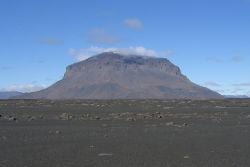
Subglacial volcanoes develop underneath icecaps. They are made up of flat lava flows atop extensive pillow lavas and palagonite. When the icecap melts, the lavas on the top collapse leaving a flat-topped mountain. Then, the pillow lavas also collapse, giving an angle of 37.5 degrees. These volcanoes are also called table mountains, tuyas or (uncommonly) mobergs. Very good examples of this type of volcano can be seen in Iceland, however, there are also tuyas in British Columbia. The origin of the term comes from Tuya Butte, which is one of the several tuyas in the area of the Tuya River and Tuya Range in northern British Columbia. Tuya Butte was the first such landform analyzed and so its name has entered the geological literature for this kind of volcanic formation. The Tuya Mountains Provincial Park was recently established to protect this unusual landscape, which lies north of Tuya Lake and south of the Jennings River near the boundary with the Yukon Territory.
Erupted material
Lava composition
Another way of classifying volcanoes is by the composition of material erupted (lava), since this affects the shape of the volcano. Lava can be broadly classified into 4 different compositions (Cas & Wright, 1987):
- If the erupted magma contains a high percentage (more than 63 percent) of silica, the lava is called felsic.
- Felsic lavas (or rhyolites) tend to be highly viscous (not very fluid) and are erupted as domes or short, stubby flows. Viscous lavas tend to form stratovolcanoes or lava domes. Lassen Peak in California is an example of a volcano formed from felsic lava and is actually a large lava dome.
- Because siliceous magmas are so viscous, they tend to trap volatiles (gases) that are present, which cause the magma to erupt catastrophically, eventually forming stratovolcanoes. Pyroclastic flows (ignimbrites) are highly hazardous products of such volcanoes, since they are composed of molten volcanic ash too heavy to go up into the atmosphere, so they hug the volcano's slopes and travel far from their vents during large eruptions. Temperatures as high as 1,200 °C are known to occur in pyroclastic flows, which will incinerate everything flammable in their path and thick layers of hot pyroclastic flow deposits can be laid down, often up to many meters thick. Alaska's Valley of Ten Thousand Smokes, formed by the eruption of Novarupta near Katmai in 1912, is an example of a thick pyroclastic flow or ignimbrite deposit. Volcanic ash that is light enough to be erupted high into the Earth's atmosphere may travel many kilometres before it falls back to ground as a tuff.
- If the erupted magma contains 52-63 percent silica, the lava is of intermediate composition.
- If the erupted magma contains between 45 and 52 percent silica, the lava is called mafic (because it contains higher percentages of magnesium (Mg) and iron (Fe)) or basaltic. These lavas are usually much less viscous than rhyolitic lavas, depending on their eruption temperature; they also tend to be hotter than felsic lavas. Mafic lavas occur in a wide range of settings:
- At mid-ocean ridges, where two oceanic plates are pulling apart, basaltic lava erupts as pillows to fill the gap;
- Shield volcanoes (e.g. the Hawaiian Islands, including Mauna Loa and Kilauea), on both oceanic and continental crust;
- As continental flood basalts.
- Some erupted magmas contain up to 45 percent silica and produce lava called ultramafic. Ultramafic flows, also known as komatiites, are very rare; indeed, very few have been erupted at the Earth's surface since the Proterozoic, when the planet's heat flow was higher. They are (or were) the hottest lavas, and probably more fluid than common mafic lavas.
Lava texture
Two types of lava are named according to the surface texture: ʻAʻa (pronounced IPA [ʔaʔa]) and pāhoehoe (pronounced [paːho͡eːho͡eː]), both words having Hawaiian origins. ʻAʻa is characterized by a rough, clinkery surface and is what most viscous and hot lava flows look like. However, even basaltic or mafic flows can be erupted as ʻaʻa flows, particularly if the eruption rate is high and the slope is steep. Pāhoehoe is characterized by its smooth and often ropey or wrinkly surface and is generally formed from more fluid lava flows. Usually, only mafic flows will erupt as pāhoehoe, since they often erupt at higher temperatures or have the proper chemical make-up to allow them to flow at a higher fluidity.
Volcanic activity
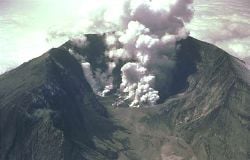
A popular way of classifying magmatic volcanoes goes by their frequency of eruption, with those that erupt regularly called active, those that have erupted in historical times but are now quiet called dormant, and those that have not erupted in historical times called extinct. However, these popular classifications—extinct in particular—are practically meaningless to scientists. They use classifications which refer to a particular volcano's formative and eruptive processes and resulting shapes, which was explained above.
There is no real consensus among volcanologists on how to define an "active" volcano. The lifespan of a volcano can vary from months to several million years, making such a distinction sometimes meaningless when compared to the lifespans of humans or even civilizations. For example, many of Earth's volcanoes have erupted dozens of times in the past few thousand years but are not currently showing signs of eruption. Given the long lifespan of such volcanoes, they are very active. By our lifespans, however, they are not. Complicating the definition are volcanoes that become restless (producing earthquakes, venting gases, or other non-eruptive activities) but do not actually erupt.
Scientists usually consider a volcano active if it is currently erupting or showing signs of unrest, such as unusual earthquake activity or significant new gas emissions. Many scientists also consider a volcano active if it has erupted in historic time. It is important to note that the span of recorded history differs from region to region; in the Mediterranean, recorded history reaches back more than 3,000 years but in the Pacific Northwest of the United States, it reaches back less than 300 years, and in Hawaii, little more than 200 years. The Smithsonian Global Volcanism Program's definition of 'active' is having erupted within the last 10,000 years.
Dormant volcanoes are those that are not currently active (as defined above), but could become restless or erupt again. Confusion however, can arise because many volcanoes which scientists consider to be active are referred to as dormant by laypersons or in the media.
Extinct volcanoes are those that scientists consider unlikely to erupt again. Whether a volcano is truly extinct is often difficult to determine. Since "supervolcano" calderas can have eruptive lifespans sometimes measured in millions of years, a caldera that has not produced an eruption in tens of thousands of years is likely to be considered dormant instead of extinct.
For example, the Yellowstone Caldera in Yellowstone National Park is at least two million years old and hasn't erupted violently for approximately 640,000 years, although there has been some minor activity relatively recently, with hydrothermal eruptions less than 10,000 years ago and lava flows about 70,000 years ago. For this reason, scientists do not consider the Yellowstone Caldera extinct. In fact, because the caldera has frequent earthquakes, a very active geothermal system (i.e., the entirety of the geothermal activity found in Yellowstone National Park), and rapid rates of ground uplift, many scientists consider it to be an active volcano.
Notable volcanoes
On Earth
The Decade Volcanoes are 17 volcanoes identified by the International Association of Volcanology and Chemistry of the Earth's Interior (IAVCEI) as being worthy of particular study in light of their history of large, destructive eruptions and proximity to populated areas. They are named Decade Volcanoes because the project was initiated as part of the United Nations-sponsored International Decade for Natural Disaster Reduction. The 17 current Decade Volcanoes are
- Avachinsky-Koryaksky (grouped together), Kamchatka, Russia
- Nevado de Colima, Jalisco and Colima, Mexico
- Mount Etna, Sicily, Italy
- Galeras, Nariño, Colombia
- Mauna Loa, Hawaii, USA
- Mount Merapi, Central Java, Indonesia
- Mount Nyiragongo, Democratic Republic of the Congo
- Mount Rainier, Washington, USA
- Sakurajima, Kagoshima Prefecture, Japan
- Santa Maria/Santiaguito, Guatemala
- Santorini, Cyclades, Greece
- Taal Volcano, Luzon, Philippines
- Teide, Canary Islands, Spain
- Ulawun, New Britain, Papua New Guinea
- Mount Unzen, Nagasaki Prefecture, Japan
- Vesuvius, Naples, Italy
Elsewhere in the Solar System
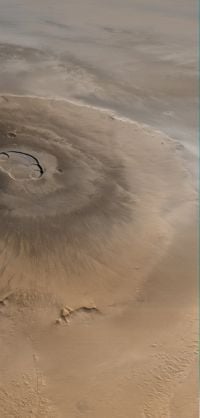
The Earth's Moon has no large volcanoes and no current volcanic activity, although recent evidence suggests it may still possess a partially molten core.[1] However, the Moon does have many volcanic features such as maria (the darker patches seen on the moon), rilles and domes.
The planet Venus has a surface that is 90 percent basalt, indicating that volcanism played a major role in shaping its surface. The planet may have had a major global resurfacing event about 500 million years ago[2] from what scientists can tell from the density of impact craters on the surface. Lava flows are widespread and forms of volcanism not present on Earth occur as well. Changes in the planet's atmosphere and observations of lightning, have been attributed to ongoing volcanic eruptions, although there is no confirmation of whether or not Venus is still volcanically active.
There are several extinct volcanoes on Mars, four of which are vast shield volcanoes far bigger than any on Earth. They include Arsia Mons, Ascraeus Mons, Hecates Tholus, Olympus Mons, and Pavonis Mons. These volcanoes have been extinct for many millions of years, but the European Mars Express spacecraft has found evidence that volcanic activity may have occurred on Mars in the recent past as well.[3]
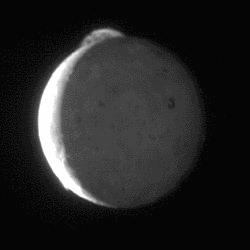
Jupiter's moon Io is the most volcanically active object in the solar system because of tidal interaction with Jupiter. It is covered with volcanoes that erupt sulfur, sulfur dioxide and silicate rock, and as a result, Io is constantly being resurfaced. Its lavas are the hottest known anywhere in the solar system, with temperatures exceeding 1,800 K (1,500 °C). In February 2001, the largest recorded volcanic eruptions in the solar system occurred on Io.[4] Europa, the smallest of Jupiter's Galilean moons, also appears to have an active volcanic system, except that its volcanic activity is entirely in the form of water, which freezes into ice on the frigid surface. This process is known as cryovolcanism, and is apparently most common on the moons of the outer planets of the solar system.
In 1989 the Voyager 2 spacecraft observed cryovolcanos (ice volcanoes) on Triton, a moon of Neptune, and in 2005 the Cassini-Huygens probe photographed fountains of frozen particles erupting from Enceladus, a moon of Saturn.[5] The ejecta may be composed of water, liquid nitrogen, dust, or methane compounds. Cassini-Huygens also found evidence of a methane-spewing cryovolcano on the Saturnian moon Titan, which is believed to be a significant source of the methane found in its atmosphere.[6] It is theorized that cryovolcanism may also be present on the Kuiper Belt Object Quaoar.
Effects of volcanoes
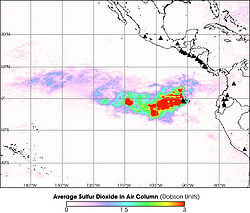
There are many different kinds of volcanic activity and eruptions: phreatic eruptions (steam-generated eruptions), explosive eruption of high-silica lava (e.g., rhyolite), effusive eruption of low-silica lava (e.g., basalt), pyroclastic flows, lahars (debris flow) and carbon dioxide emission. All of these activities can pose a hazard to humans. Earthquakes, hot springs, fumaroles, mud pots and geysers often accompany volcanic activity.
The concentrations of different volcanic gases can vary considerably from one volcano to the next. Water vapor is typically the most abundant volcanic gas, followed by carbon dioxide and sulphur dioxide. Other principal volcanic gases include hydrogen sulphide, hydrogen chloride, and hydrogen fluoride. A large number of minor and trace gases are also found in volcanic emissions, for example hydrogen, carbon monoxide, halocarbons, organic compounds, and volatile metal chlorides.
Large, explosive volcanic eruptions inject water vapor (H2O), carbon dioxide (CO2), sulfur dioxide (SO2), hydrogen chloride (HCl), hydrogen fluoride (HF) and ash (pulverized rock and pumice) into the stratosphere to heights of 10-20 miles above the Earth's surface. The most significant impacts from these injections come from the conversion of sulphur dioxide to sulphuric acid (H2SO4), which condenses rapidly in the stratosphere to form fine sulfate aerosols. The aerosols increase the Earth's albedo—its reflection of radiation from the Sun back into space - and thus cool the Earth's lower atmosphere or troposphere; however, they also absorb heat radiated up from the Earth, thereby warming the stratosphere.
Several eruptions during the past century have caused a decline in the average temperature at the Earth's surface of up to half a degree (Fahrenheit scale) for periods of one to three years. The sulphate aerosols also promote complex chemical reactions on their surfaces that alter chlorine and nitrogen chemical species in the stratosphere. This effect, together with increased stratospheric chlorine levels from chlorofluorocarbon pollution, generates chlorine monoxide (ClO), which destroys ozone (O3). As the aerosols grow and coagulate, they settle down into the upper troposphere where they serve as nuclei for cirrus clouds and further modify the Earth's radiation balance. Most of the hydrogen chloride (HCl) and hydrogen fluoride (HF) are dissolved in water droplets in the eruption cloud and quickly fall to the ground as acid rain. The injected ash also falls rapidly from the stratosphere; most of it is removed within several days to a few weeks. Finally, explosive volcanic eruptions release the greenhouse gas carbon dioxide and thus provide a deep source of carbon for biogeochemical cycles.
Gas emissions from volcanoes are a natural contributor to acid rain. Volcanic activity releases about 130 to 230 teragrams (145 million to 255 million short tons) of carbon dioxide each year.[7] Volcanic eruptions may inject aerosols into the Earth's atmosphere. Large injections may cause visual effects such as unusually colorful sunsets and affect global climate mainly by cooling it. Volcanic eruptions also provide the benefit of adding nutrients to soil through the weathering process of volcanic rocks. These fertile soils assist the growth of plants and various crops. Volcanic eruptions can also create new islands, as the magma cools and solidifies upon contact with the water.
In culture
Past beliefs
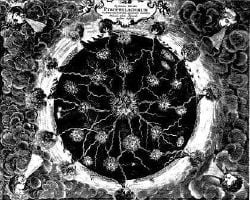
Many ancient accounts ascribe volcanic eruptions to supernatural causes, such as the actions of gods or demigods. One early idea counter to this was Jesuit Athanasius Kircher (1602-1680), who witnessed eruptions of Aetna and Stromboli, then visited the crater of Vesuvius and published his view of an Earth with a central fire connected to numerous others caused by the burning of sulfur, bitumen and coal.
Various explanations were proposed for volcano behavior before the modern understanding of the Earth's mantle structure as a semisolid material was developed. For decades after awareness that compression and radioactive materials may be heat sources, their contributions were specifically discounted. Volcanic action was often attributed to chemical reactions and a thin layer of molten rock near the surface.
Heraldry
The volcano appears as a charge in heraldry.
Panoramas
Notes
- ↑ M. A. Wieczorek, B. L. Jolliff, A. Khan, M. E. Pritchard, B. P. Weiss, J. G. Williams, L. L. Hood, K. Righter, C. R. Neal, C. K. Shearer, I. S. McCallum, S. Tompkins, B. R. Hawke, C. Peterson, J, J. Gillis, and B. Bussey, "The Constitution and Structure of the Lunar Interior." Reviews in Mineralogy and Geochemistry 60(1) (2006): 221-364.
- ↑ D. L. Bindschadler, Magellan: A new view of Venus' geology and geophysics. Reviews of Geophysics, July 1995. Retrieved May 18, 2018.
- ↑ Glacial, volcanic and fluvial activity on Mars: latest images European Space Agency, February 25, 2005. Retrieved May 18, 2018.
- ↑ Exceptionally Bright Eruption on lo Rivals Largest in Solar System. W. M. Keck Observatory, November 13, 2002. Retrieved May 18, 2018.
- ↑ Cassini Finds an Atmosphere on Saturn's Moon Enceladus. Jet Propulsion Laboratory. Retrieved May 18, 2018.
- ↑ David L Chandler, Hydrocarbon volcano discovered on Titan New Scientist, June 8, 2005. Retrieved May 8, 2018.
- ↑ Volcanic gases can be harmful to health, vegetation and infrastructure U.S. Geological Survey. Retrieved May 18, 2018.
ReferencesISBN links support NWE through referral fees
- Cas, R. A. F., and J. V. Wright. Volcanic Successions. Norwell, MA: Unwin Hyman Inc., 1987. ISBN 0045520224
- Macdonald, Gordon A., and Agatin T. Abbott. Volcanoes in the Sea. Honolulu, HI: University of Hawaii Press, 1970. ISBN 0824808320
- Marti, Joan, and Gerald Ernst. Volcanoes and the Environment. Cambridge, UK: Cambridge University Press, 2005. ISBN 0521592542
- Ollier, Cliff. Volcanoes. Oxford, UK: Basil Blackwell, 1988. ISBN 0631159770
- Sigurðsson, Haraldur (ed.) Encyclopedia of Volcanoes. Burlington, MA: Academic Press, 1999. ISBN 012643140X This is a reference aimed at geologists, but many articles are accessible to non-professionals.
External links
All links retrieved May 9, 2020.
- Smithsonian Institution - Global Volcanism Program.
- How Volcanoes Work by Tom Harris.
- How Volcanoes Work - Educational resource on the science and processes behind volcanoes, intended for university students of geology, volcanology and teachers of earth science.
- Natural Disasters - Volcano Great research site for kids.
- Mount St. Helens Post-Eruption Chemistry Database This collection contains photographs of Mount St. Helens, post-eruption, taken over the span of three years to provide a look at both the human and the scientific sides of studying the eruption of a volcano.
- Mount St. Helens Succession Collection This collection consists of 235 photographs in a study of plant habitats following the May 18, 1980 eruption of Mount St. Helens.
Credits
New World Encyclopedia writers and editors rewrote and completed the Wikipedia article in accordance with New World Encyclopedia standards. This article abides by terms of the Creative Commons CC-by-sa 3.0 License (CC-by-sa), which may be used and disseminated with proper attribution. Credit is due under the terms of this license that can reference both the New World Encyclopedia contributors and the selfless volunteer contributors of the Wikimedia Foundation. To cite this article click here for a list of acceptable citing formats.The history of earlier contributions by wikipedians is accessible to researchers here:
The history of this article since it was imported to New World Encyclopedia:
Note: Some restrictions may apply to use of individual images which are separately licensed.
